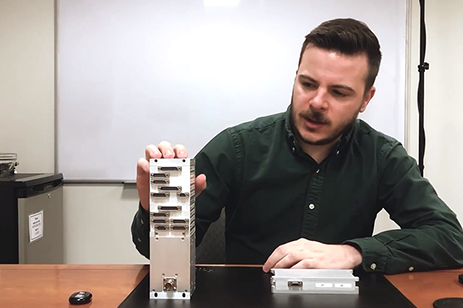
The TTC-MDW DAU family is optimally designed for those FTI applications, such as hypersonic ordnance and rotorcraft that require a more compact, balanced solution. This video shows the new MDW-2020 form factor miniature data acquisition system.
Transcript
Hello, my name is Brandon Rosso and I'm an Application Engineer at Curtiss-Wright Newtown. The purpose of this video is to show the new MDW-2020 form factor which is our latest addition to our miniature data acquisition series product family.
The goal of this demonstration is to show the feature set that the MDW-2020 form factor brings to our miniature data acquisition series product family.
On my right is a typical miniature data acquisition series encoder unit, which traditionally has stacked vertically from the power supply up. So if you're unfamiliar with this unit, it goes power supply, overhead, and then the various I/Os that a program might need to instrument.
Now this stack has been flown and tested for the last twenty years on various programs all over the world. Very recently we have had various types of hypersonic and rotary programs that have needed a more compact and smaller solution that this form factor could not offer.
Our solution to that problem was to repackage a power supply so it didn't have just a singular column but two columns. Now what this allows is both these columns to share the power supply and the backplane while still using one overhead. So what that allows you to do is have a reduction in your height and a reduction in your total volume and weight.
Now what I'll be doing here is disassembling this stack and putting it into this form factor to compare the size difference between the two.
Now, typically there is mounting screws here. I've already taken them out of the stack to make this demonstration easier. This stack consists of ten modules, one overhead unit and nine I/O modules. So there's an equal balance on both sides when I go to transition this stack to here.
So I'm going to simply take the modules off like so and just like previously on one of these sides, the overhead will be on the bottom and then you will stack the I/Os on top of that and then on the other side will simply be just I/Os.
And you can see, here we go, here's the finished product. Now what we can see is there is a dramatic difference in the size when we compare the before and the after. This stack with all the I/Os and overhead was roughly 8-and-a-half inches tall. This is now roughly 3-and-a-quarter inches tall. So that is a reduction in height of about 60% without sacrificing the channel density of your actual encoder unit.
Thank You